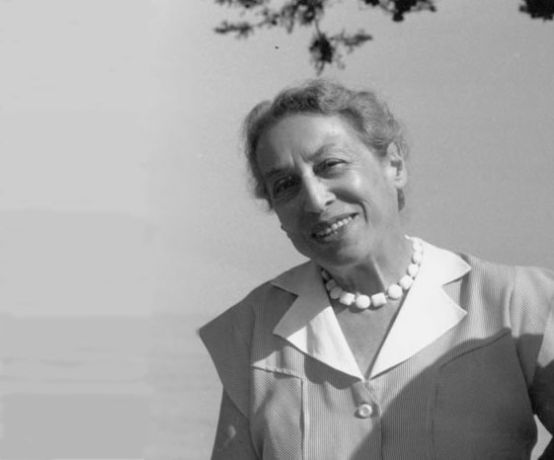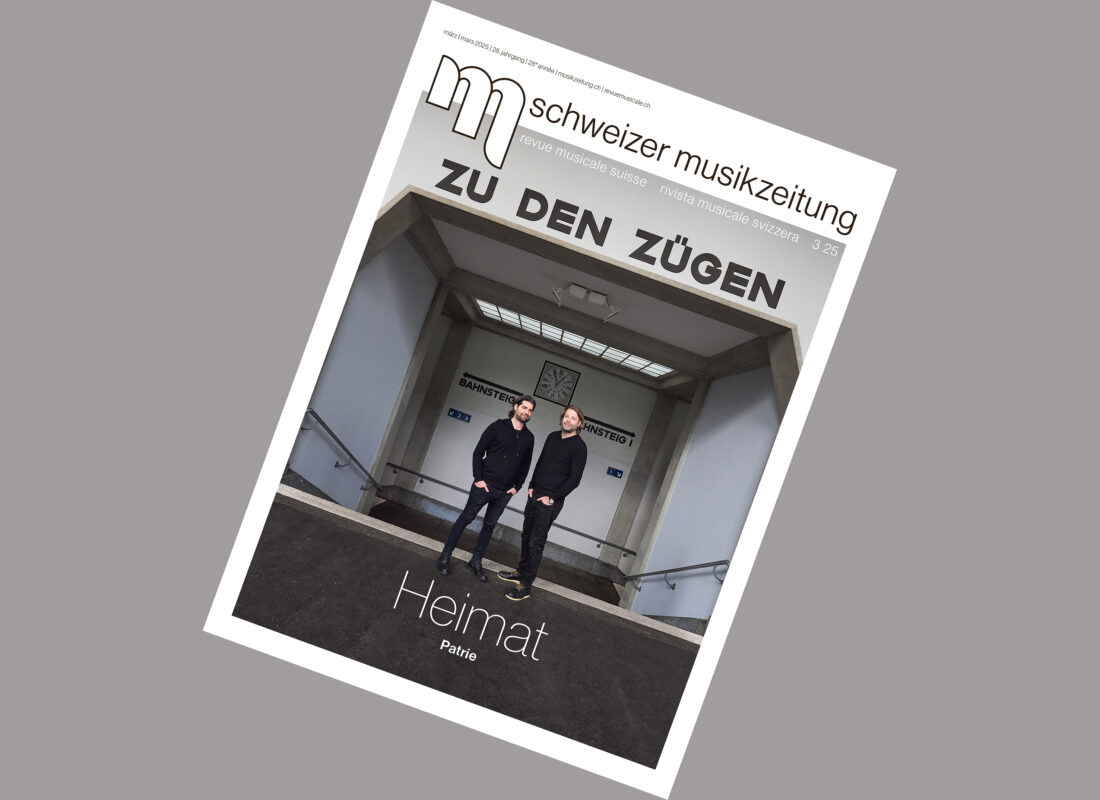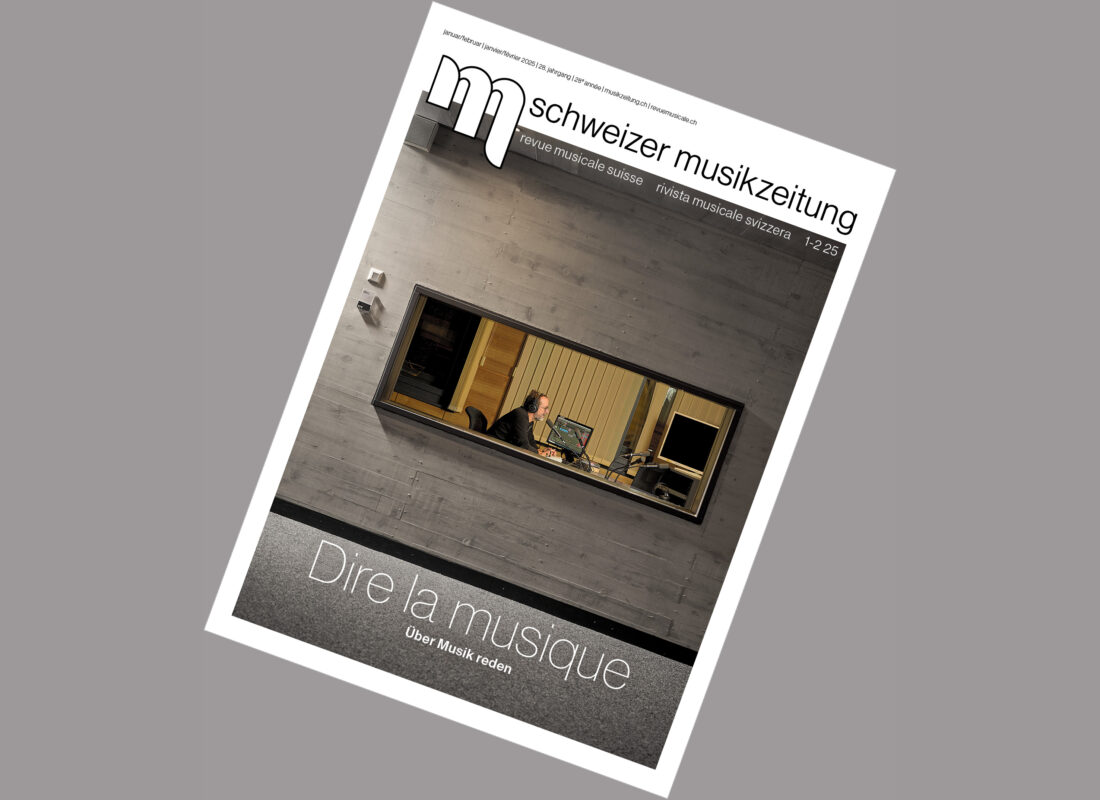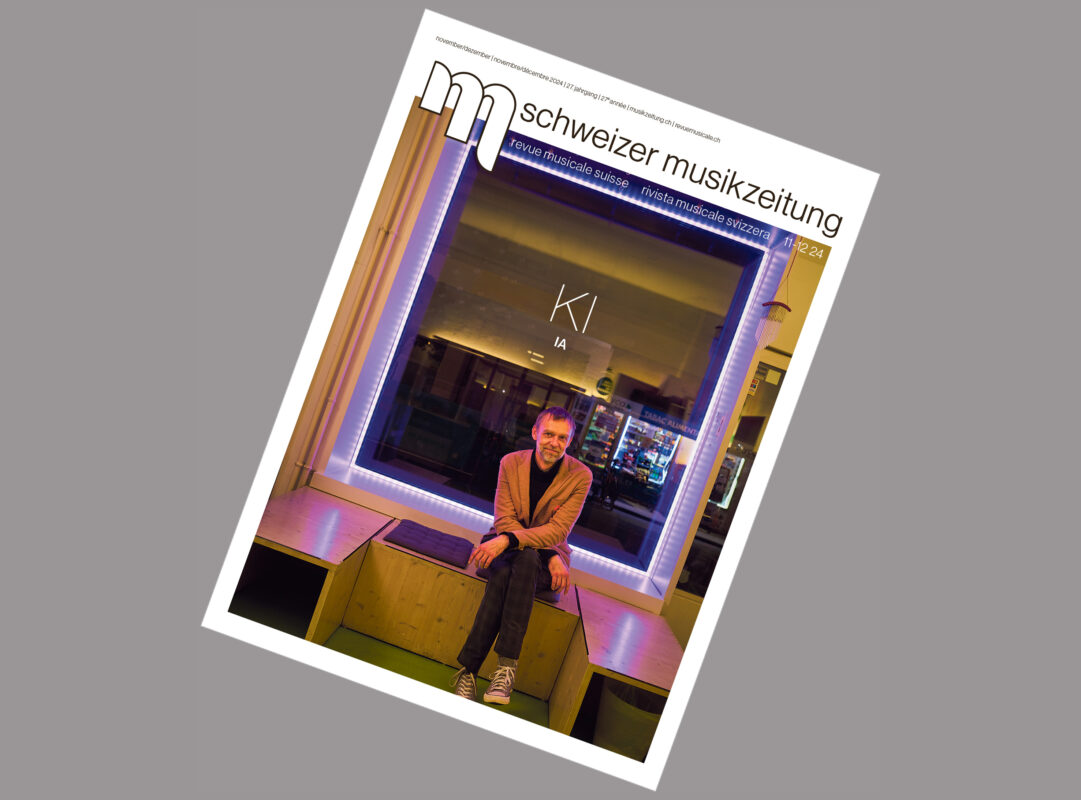Reforms in music teaching
Better, more varied music lessons! This call was heard again and again. This was countered by statements from skeptical musicians. Clara Haskil said that piano lessons were not a matter of learning. You can just do it! The Hungarian piano teacher Margit Varró, on the other hand, gave useful instructions throughout her life in countless lectures and teaching courses as well as in her 1929 textbook "The Living Piano Lesson", which is still current and available. She visited Switzerland in 1938 on the occasion of the 3rd Congress of the International Society for Music Education, founded two years earlier by Leo Kestenberg and like-minded people. Ruth-Iris Frey-Samlowski's dissertation, published in 2012, deals with her life and work.


Better, more varied music lessons! This call was heard again and again. This was countered by statements from skeptical musicians. Clara Haskil said that piano lessons were not a matter of learning. You can just do it! The Hungarian piano teacher Margit Varró, on the other hand, gave useful instructions throughout her life in countless lectures and teaching courses as well as in her 1929 textbook "The Living Piano Lesson", which is still current and available. She visited Switzerland in 1938 on the occasion of the 3rd Congress of the International Society for Music Education, founded two years earlier by Leo Kestenberg and like-minded people. Ruth-Iris Frey-Samlowski's dissertation, published in 2012, deals with her life and work.
Efforts to improve music teaching in schools, music schools and private lessons are old and still relevant today. Founded in 1893, the Swiss Music Pedagogical Association (SMPV) has, according to its statutes, strived from the beginning to the present day to, among other things, "unite ... professionally trained and music-pedagogically active professional musicians ... for the purpose of promoting music education in Switzerland". 102 years ago, it introduced strict diploma examinations for this purpose, a training program that is continued today at the Kalaidos University of Applied Sciences. The organization of congresses, lectures and further education courses in Switzerland flourished in the 1930s.
Three ISME congresses
At the same time, such efforts were supported by the institution now known as the International Society for Music Education (ISME). Under the leadership of Leo Kestenberg, it held its first congress in Prague in 1936, the second in Paris in 1937 and the third in Switzerland in 1938. The accomplished concert pianist Leo Kestenberg (1882-1962), born in Rosenberg, Hungary (now Slovakia), had been involved in social democratic educational work since 1900. This was a matter close to his heart and he organized concerts and events for the general public in Berlin, where he taught piano at various conservatories. In 1918, after the end of the war, he was appointed music officer in the Prussian Ministry of Science, Art and National Education and continued to teach piano, from 1921 as a professor at the Hochschule für Musik. His book Music education and music cultivation of 1921 attracted a great deal of attention. Many of the ministry's decrees on music education in and out of school originated from his pen. He organized annual Reich School Music Weeks until he was abruptly retired in 1932 (as a socialist and Jew even before the seizure of power!) and emigrated to Prague. In 1938, he fled to Paris, where he received an appointment to Tel Aviv.
It was an eventful time. I take the following from the dissertation The life and work of Margit Varrós by Ruth-Iris Frey-Samlowski (my review of this book can be found at here). The Prague Congress was boycotted by the Axis powers Germany and Italy as well as Russia. 700 delegates and 21 government representatives were invited, from Switzerland Emile Jaques-Dalcroze, Walter Simon Huber (the father of Klaus Huber), the director of the Zurich Conservatory Carl Vogler and Willy Schuh, who wrote a detailed report for the Swiss Music Newspaper in which he described his goal as In it, he described his goal as "a departure towards the musical activation of the whole people in contrast to the mere pleasurable passivity of a limited group of listeners and the mechanization and flattening of musical life". Margit Varró had missed this event for unknown reasons, but was invited by Leo Kestenberg to a lecture in Prague on "Musical talent and personal habitus" and a radio broadcast in Holy Week 1937. He received them personally, showed them around a large music library with teaching materials that was being set up in the Ministry of Foreign Affairs (the Foreign Minister Dr. Kamil Krofta was personally involved in Kestenberg's work) and the Smetana Museum. This was the beginning of a lifelong friendship that was to be decisive for them. Her performances were well received by numerous listeners and in the press.
Just one month later, she traveled to Paris, where the second congress took place at the same time as the world exhibition "Art et Technique". Her lecture "La réceptivité musicale de l'enfant et l'adolescent" on a psychologically substantiated basis, from infant and toddler onwards, published in French and Hungarian, aroused great interest. This congress, with significantly fewer delegates, namely 95 from 14 countries, was also boycotted by Germany, but was widely reported in the international press. Illustrious speakers from Switzerland, who were temporarily resident there at the time, Walter Damrosch, Ernst Krenek, Alois Hába, Curt Sachs and Jaroslav Krika, as well as the following Swiss: W. S. Huber, who worked in the Swiss Music Newspaper and in the Swiss music education journals and Hugo Keller, who contributed an "exposé". "Concerts for young people with age-appropriate mediation" was the main topic of the congress, which interested Margit Varró all the more as she had already organized countless concerts in Hungary herself. Ernst Schelling, who had conducted the New York Philharmonic's "Young People's Concerts" from 1924, Robert Mayer from London and the German-American Walter Damrosch reported on their experiences in concerts and on the radio, while the quarter-tone composer Hába and Krenek were particularly committed to contemporary music.
Varró had already visited Switzerland before 1930. A surviving photograph bears witness to this. In 1936, she traveled to Bern, probably for a teaching demonstration. In attendance was the well-known pianist, music teacher and musicologist Eduard Rüfenacht, whose book The purpose and task of music educationFrancke-Verlag Bern, included it in the last, expanded edition of her textbook in 1958. In 1937, on her trip to Paris, she gave a lecture to the Basel SMPV local group on the same topic as previously in Prague, with a detailed discussion in the Swiss music education journals M. W., probably Walter Müller von Kulm. Finally, in 1938, she stayed longer in Switzerland before taking part in the third International Congress, which lasted a week (June 23 to 28). Prior to this, the date is not known, she gave a lecture on "L'enseignement vivant du piano" at the Ecole normale de Musique in Paris and two lectures in Brussels on June 20 on "Le talent musical" and "Les nouveaux buts de l'enseignement musical".
Unfortunately, no more programs or lists of participants from the Swiss congress can be found, a fact that suggests little archival care in the SMPV. However, Ruth-Iris Frey-Samlowski has succeeded in reconstructing a detailed program from press reports in the 14 participating countries (including this time, in neutral Switzerland, also Germany!), which is still so interesting today with its approximately 50 papers and presentations that it is offered here in abbreviated form:
The Swiss Congress "Music Education and Special Needs Education"
Zurich, June 23 and 24
- Greetings in the auditorium of the Höhere Töchterschule: Fritz Enderlin, Rector; Jaroslav Jindra, Ministerial Secretary, Prague; Leo Kestenberg, Prof. Dr. Antoine-E. Cherbuliez, President SMPV Zurich chapter; Prof. Dr. med. Miroslav Seemann, Charles University, Prague.
- Presentations: Prof. Dr. Heinrich Hanselmann, Zurich, "Music education and curative education";
- Prof. Dr. György Révész, Amsterdam, "The psychobiological significance of music education for the blind and deaf-mute";
- Prof. Dr. M. Seemann, "The tasks of the doctor in the care of the deaf and dumb".
- Practical demonstrations: Mimi Scheiblauer and Olga Zollinger, Zurich (assistance), "Musical-rhythmic education for the deaf-mute and infirm" at the Wollishofen institution for the deaf-mute and on the excursion to the Bühl institution in Wädenswil (mental patients) and to the Albisbrunn rural education home (children with learning difficulties).
Bern, June 25
- Greetings in the Schulwarte, Bern: Kurt Joss, President of the SMPV local group Bern; Dr. E. Bärtschi, principal of the city of Bern; Prof. Dr. M. Seemann, Prague; Mr. Wöldike, Copenhagen.
- PresentationsEduard Rüfenacht, Bern, "The educational significance of musical improvisation";
- Dr. Ernst Ferand, Hellerau/Laxenburg, "Die psychologischen Grundlagen der Improvisation" (his dissertation, Vienna 1937, "Die Improvisation in der Musik" contains its comprehensive history);
- Prof. Dr. Henri Vallon, Paris, "Movement and music, a physio-pathological study".
- Gertrud Biedermann, Bern, "Lesson with children in bamboo flute carving and playing"
- Gertrud von Goltz, Bern, spoke about her experiences in singing lessons at the Hilfsschule Bern.
- Rhythmic-musical demonstration: Ernst Müller, director of the institution for feebleminded children Weissenheim/Bern,
- ConcertHugo Keller, Bern (choirmaster) with the Berner Singbuben and the Röseligartenchor
On June 26, a visit to the Faulensee/Spiez institution for the blind was also on the agenda. Gottfried Kölliker, a blind music teacher, gave a presentation on the high educational value of the musical care he provides at this institution, supplemented by a choir and orchestra concert.
Basel, June 27 and 28
Focus: musical education for the mentally ill and developmentally disabled
- Greetings in the council chamber of the half-canton of Basel-Stadt: Dr. Fritz Hauser, member of the cantonal government, current president of the National Council; J. Jindra, Prague; L. Kestenberg; Dr. F. Wenk, secretary of the Basel-Stadt Department of Education (moderator); Bourgoin, inspector general, Paris; Prof. Dr. Xirau, government representative, Barcelona; Dr. Fr. Wenk, secretary of the Basel-Stadt Department of Education (president of the day).
- Performances at the official reception in the foyer of the Kunstmuseum Basel: Basler Waisenknaben with Guggemusig; Ernst Sigg, director of the Collegium Musicum der Knabengymnasien; E. Jakob, songs by the Sissach traditional costume group; Dr. Gustav Güldenstein, music theory teacher at the Basel Conservatory, dances by Mozart and Dvořák.
- PresentationsL. Kestenberg and Walter Müller von Kulm, SMPV Basel and Director of the Conservatory (both untitled);
- Prof. Alois Hába, Prague, "Healing powers of music education in our time";
- Willy Overhage, short presentation.
- Visits in and near Basel: Baselstädtische Anstalt für Geisteskranke Friedmatt with a presentation by Prof. Dr. John Staehelin "Die diagnostischen, prognostischen und therapeutischen Vorteile einer musikalischen Heilpädagogik" and a presentation by Helene Horsberger, Basel, "Rhythmik mit verschiedenen Gruppen von Geisteskranken"; Anstalt zur Hoffnung, Riehen, with a presentation by Melita Kosterlitz, Hellerau/Laxenburg, "Gymnastik mit einer Gruppe schwachbegabter Kinder"; Öffentliche Primarschulen der Stadt Basel, presentations by W. S. Huber, "Overview of the external and internal structure of school music education in Basel" and "Essential requirements of modern school education", three lessons based on the "Lechner method", which has been made compulsory for elementary school in Basel, and Esther Gutknecht, teacher of a girls' primary class, presentation with an insight into the teaching methods of music education at public elementary school and a performance of a self-created musical play by female pupils.
- Visits outside BaselGoetheanum Dornach, lecture by Werner Pache "Structure of anthroposophical music education";
- Sonnenhof in Arlesheim, lecture by Dr. Julia Bort, "The importance of music and healing eurhythmics in Rudolf Steiner's curative education";
- "Home for children in need of spiritual care"
The congress passed the following resolution, edited by Goldschmid (probably Rev. Theodor Goldschmid, hymnologist and composer, Central President of the Swiss Church Hymnal Federation 1896-1937), Rudolf Schoch, Zurich and W. S. Huber Resolution:
"The participants of the International Working Conference for Music Education and Curative Education, which met in Zurich, Berne and Basel from June 23 to 28, 1938, thank the Society for Music Education in Prague, the Swiss Music Education Association, the curative education department of the University of Zurich and the educational authorities of the conference venues for organizing this congress, which gave them an insight into the possibilities of using music to achieve curative educational success with the infirm, severely educable, mentally weak, blind and deaf-mute.
They express the wish that the collected observations be deepened through more experiments and that the experiences be exchanged through the mediation of the Central Office in Prague. They have gained the conviction that the pedagogical and psychological results of this work are of decisive importance for education as a whole. They expect that the next international congress in Prague in 1939 will continue to pursue the problems of the special conference on the basis of general music education."
Even if the topic was more specialized this time, the congress must have had a tremendous impact in Switzerland, not only in curative education, but for the overall importance of music education. The two specialist journals and many daily newspapers reported on it in detail. The stream of visitors at all three conference venues was overwhelming and exceeded the boldest expectations. I got an idea of this through the rhythm and piano teacher Olga Zollinger, who performed with Mimi Scheiblauer in Zurich. She worked in England for several years after the war and from there brought the idea of so-called voluntary student examinations (level tests) to Zurich, which experienced their first heyday from 1965-79 in the Zurich SMPV local group and have now spread far and wide, especially in Lucerne and at the Zurich Youth Music School. The aim of these level tests is to teach children not only technical mastery of the instrument, but also a comprehensive musical education with ear training, general music theory, elementary harmony and form theory as well as improvisation (invention exercises), i.e. exactly in line with the thrust of the three congresses mentioned above and also in accordance with Varró's demands. I got to know Olga Zollinger well during my time as president of this local group in 1971-82. Even then, she spoke enthusiastically about the impulses she had received in 1938 and before and the direction she had taken.
The planned congress in Prague in 1939 did not take place. Czechoslovakia had been overrun by Hitler's Germany and Kestenberg, the spiritus rector, had managed to escape to Tel Aviv. The ISME had to be re-founded after the World War, in Brussels in 1953 under the auspices of Unesco.
I would like to take this opportunity to pay tribute to my first piano teacher, Hans Rogner. The Viennese had settled down in Zurich, was employed at the conservatory as a piano and theory teacher, conductor of the professional school orchestra and librarian, and composed charming and modest music, for example stage music for the marionette plays of Ambrosius Humm, the son of the well-known writer Jakob Humm, who provided the texts. Rogner implemented what I only realized later, exactly the reform ideas received in the thirties, not least from Margit Varró, without her name ever appearing in class. He wove ear training and general music theory into the lessons. For the latter, he humorously wrote the "Musica" booklets available from Jecklin together with Ernst Hörler with drawings, for example of the interval lake and the wooden tone ladder with the two narrower rungs per octave. This was no gray theory, he let his students sing, improvise and compose. However, it is almost impossible to teach such a wide range of skills in half-hour lessons. He deducted ten minutes from the 60 minutes of individual lessons, took a group of six pupils together and gave one additional "theory lesson" per week.








